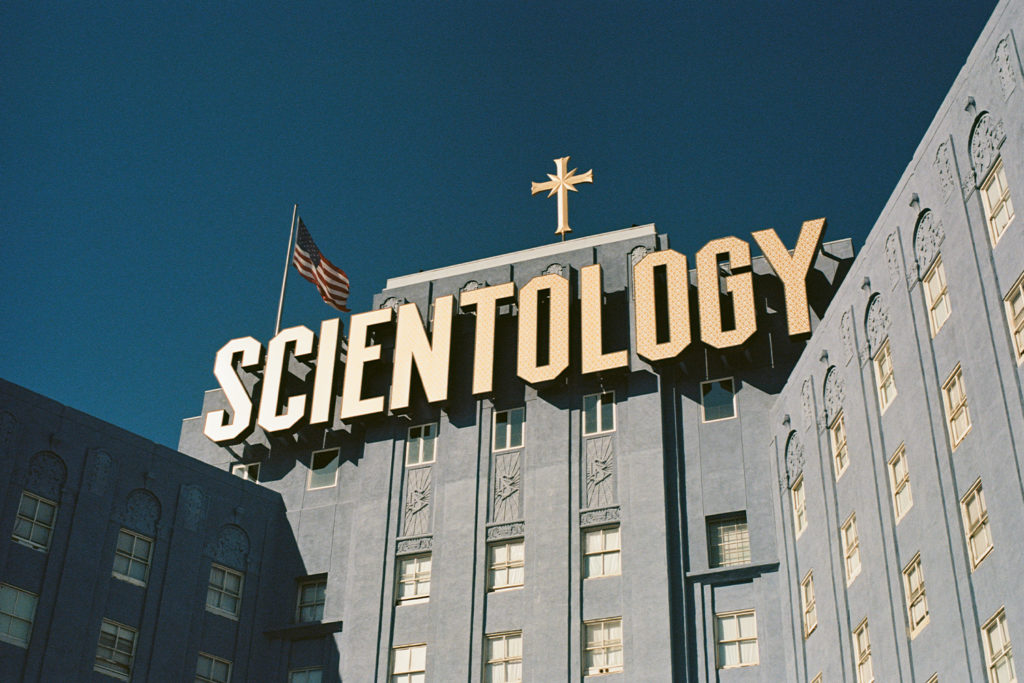By Tal Davis
Official Name: Church of Scientology International
Founder: L. Ron Hubbard, in 1954
Current Leaders: David Miscavige, (b. 1960); Heber C. Jentzsch (b.1935)
Headquarters: Los Angeles, Calif.; Clearwater, Fla. (Flag Land Base)
Organizations Associated with Scientology:
Applied Scholastics, Association for Better Living and Education (ABLE)
Citizens Commission on Human Rights,
Concerned Businessmen’s Association of America,
The Hubbard Dianetics Foundation International,
Narconon/Criminon,
National Commission on Law Enforcement and Social Justice,
Religious Technology Center,
Sterling Management Systems,
The Way to Happiness Foundation,
World Institute of Scientology Enterprises (WISE),
Publishing Organizations:
New Era Publications,
International;
Bridge Publications, Inc.
Key Publications:
Dianetics: The Modern Science of Mental Health (1950) and other books by L. Ron Hubbard;
What is Scientology? (1978) compiled by staff of the Church of Scientology International;
Freedom magazine.
This Belief Bulletin highlights basic concepts of Scientology and gives Biblical responses.
History:
Lafayette Ronald Hubbard was born in Nebraska in 1911. He spent most of his childhood on his grandfather’s Montana ranch while his parents served overseas in the U.S. Navy. Hubbard later stated that visits with parents to Asia in the 1920s introduced him to eastern philosophies and religions.
As a young man, Hubbard developed a career as a science fiction writer and claimed to have explored the world. He also claimed that he received near fatal wounds in World War II. While recovering, he formulated his novel psychological theories that were revealed in his 1950 book Dianetics: The Modern Science of Mental Health.
In 1954, Hubbard incorporated the Church of Scientology to promote his ideas using a religious facade. His books and church spread worldwide, but Hubbard became a recluse. He spent most of his last years aboard his yacht being waited on hand-and-foot. He died inauspiciously in 1986.
Commonly Used Scientology Terms
Analytical mind: The conscious, rational, and problem solving part of one’s mind. Auditing: Scientology’s personal counseling using dianetic techniques and utilizing an E- meter for reading engrams.
Auditing: Scientology’s personal counseling using dianetic techniques and utilizing an E-meter for reading engrams.
Auditor: Counselor who conducts auditing session.
Clear: State of person who has completed auditing. Person is supposedly liberated from all engrams and their ill effects on the mind and body.
Dianetics: Method developed by L. Ron Hubbard for removing engrams and their negative effects from the mind.
E-Meter (Electropsychometer): Instrument invented by L. Ron Hubbard for utilization in auditing process.
Engram: Unconscious mental image recorded in the reactive mind that has negative effects on a person’s life.
MEST: Acronym coined from the initial letters of matter, energy, space, and time which compose the physical universe and hold the thetan captive.
Preclear: A person undergoing Dianetics auditing progressing toward Clear.
Reactive mind: The part of the mind not under a person’s rational, conscious control or awareness.
Thetan: The immortal human soul or spiritual being. It is the true, timeless identity of the individual.
Beliefs and Practices
L. Ron Hubbard was a modern genius who discovered the answers to life’s questions and unraveled the secrets of our past, present, and future existences. His writings and speeches are considered absolutely authoritative, especially his book Dianetics: The Modern Science of Mental Health.
Biblical Response: Researchers not associated with the Church of Scientology have documented inaccuracies in Hubbard’s account of his life. They allege he fabricated and exaggerated many of his personal claims. His theories directly conflict with basic Christian teachings. Only the Bible is the infallible basis for faith and practice (2 Tim. 3:16; 2 Pet. 1:20-21).
Immortality
People are immortal, divine beings. They are composed of three dimensions: soul (thetan), mind (an accumulation of all past experiences in this and past lives), and body (the mortal, temporary physical component).
Biblical Response: People are souls created in the spiritual image and likeness of God (Gen. 1:26-30; 2:7). They are twofold in nature, body, and spirit. The body is mortal and the spirit immortal. There is no existence before earthly life.
God
The Church of Scientology International has no clear definition of the nature or person of God. References to a Supreme Being are rare in Scientology literature, calling it the “eight dynamic” or “infinity.” The Supreme Being is defined in vague, pantheistic terms as embracing the “allness of all.”
Biblical Response: God is the eternal, infinite, personal Creator of the universe (Gen. 1; Deut. 6:4). He is Spirit (Num. 23:19; John 4:24) and has existed from all eternity in a triune form: Father, Son, and Holy Spirit (Matt. 28:19; 1 Cor. 12:4-6).
Humankind
Engrams are stored in one’s “reactive mind” and learned from one’s past lives, prenatal experience, and early childhood. These prevent individuals from realizing their innate divinity and experiencing a happy and fulfilled life using their analytical minds.
Biblical Response: Humankind’s problem is sin, an attitude of rebellion or indifference toward God and His will, resulting in separation from God, both in this life and forever (Mark 7:20-23; Rom. 3:23; 6:23; 1 John 3:4; 5:17).
Scientology’s Solution – Auditing
Engrams are removed from the mind only by an expensive process of dianetic counseling. This process, called “auditing,” involves the utilization of an “E-meter” that supposedly indicates when a person has discovered an engram and helps the client expunge it from his or her unconscious reactive mind in order to achieve “Clear.” A person who has attained Clear may need further auditing to remove engrams held over from previous lives. Auditing sessions may cost as much as $1,000 per hour.
Biblical Response: Jesus Christ is God’s solution to the sin problem. He was God Himself, in human form on earth (John 3:16; 14:6; 1 Tim. 2:5-6; 1 Pet. 3:18). He lived a sinless life, died as an atoning sacrifice for sin, and rose from the dead. People thus receive salvation as a gift, both as a present reality and future hope, by grace through faith in Jesus Christ (John 14:1; Rom. 10:9-10; Gal. 2:15-16; Eph. 2:8-9).
The Ultimate Goal – Liberation from MEST
A person will experience many thetan reincarnations in many lives over thousands of years. (Thus, auditing often must include clearing the client of engrams from past lives.) Eventually, the thetan can liberate itself completely from MEST and attain total spiritual awareness and become one with infinity.
Biblical Response: Born-again Christians will live forever with God and Jesus in heaven (John 14:3-6; Rom. 6:23; 8:35-39; Rev. 20-22). Jesus taught that the righteous will have eternal life, but the unsaved will suffer eternal punishment in hell (Matt. 25:46). Reincarnation is nowhere taught in the Bible. People live one earthly life and then face God’s judgment (Heb. 9:27).
Witnessing to Scientologists
- Have a clear understanding of your faith and the Bible.
- Ask appropriate questions to determine the person’s level of involvement in Scientology and/or Dianetics. Many people involved do not understand its philosophical, spiritual, and scientific problems, nor its incompatibility with historic Christianity. In some cases, you may need to provide documentation to show the Scientologist that L. Ron Hubbard was not what Scientologists believe him to be and expose the controversial history of the Scientology movement. (See Brent Corydon, L. Ron Hubbard: Messiah or Madman [Barracade Books, 1994] and Russell Miller, Bare-Faced Messiah: A Biography of L. Ron Hubbard [H. Holt & Co., 1988].)
- Seek to establish a personal, friendly relationship with the Scientologist.
- Establish the sole authority of the Bible. You may need to give the Scientologist a marked Bible to highlight basic Christian doctrines.
- Clearly define all terms of Scientology and historic Christianity.
- Show the Scientologist how Christian doctrines are incompatible with Scientology. Focus especially on contrasting ideas about God, sin, salvation, and life after death.
- Share your personal testimony of faith in Jesus Christ and the benefits you derive from knowing Him as Savior and Lord.
- Share the plan of salvation and sensitively seek to lead the person to faith in Jesus.
Published March 30, 2016




